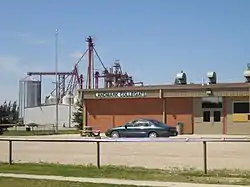Landmark, Manitoba
Landmark, originally called Prairie Rose, is an unincorporated community recognized as a local urban district[2] in the province of Manitoba, Canada, located about 30 km (18.6 mi) southeast of the provincial capital, Winnipeg, in the Rural Municipality of Taché. Landmark's population at the 2016 census was 1,292.
Landmark | |
|---|---|
Unincorporated community | |
 Landmark high school with Landmark Feeds in the background | |
| Coordinates: 49°40′18″N 96°49′18″W | |
| Settled | 1907 |
| Area | |
| • Total | 2.98 km2 (1.15 sq mi) |
| Elevation | 242 m (794 ft) |
| Population (2016) | |
| • Total | 1,292 |
| • Density | 430/km2 (1,100/sq mi) |
| Postal Code | R0A 0X0 |
| Area code(s) | Area codes 204 and 431 |
Landmark serves largely as a dormitory community or exurb for people who work in Winnipeg but prefer to reside in a smaller community.
The Landmark businesses have, through the years, highlighted that the community lies on the longitudinal centre of Canada.
Landmark lies in an area with rich black soil known to yield fine crops. Situated in a low-lying area, the community relies on drainage provided by the constructed Seine River Diversion to minimize flooding caused by the spring melt.
History
Although at least four homesteads were established in about 1907, much of the area was barren until just after World War I.[3] It was at this time that a number of Mennonite families living in the neighbouring East Reserve faced shortages of land for agricultural expansion. By 1920, a dozen Mennonite families had purchased land in the area and had begun establishing their new farms. Within a year of that, the area had its first church building, and by 1925 a school district had been organized.[4]
The main transportation link in the Landmark area in the early years was the Old Dawson Trail, a crude road that led westward to Winnipeg and eastward to Ste. Anne.[4]
In about 1920, the east part of the area of Prairie Rose was registered as the name "Landmark", being picked at random from a list of names in the "Farmer's Advocate" by early resident Peter M. Penner and his eldest son.[5]
Numerous businesses sprung up in Landmark in the 1950s. One of the first businesses in the Landmark area, a repair shop named Landmark Motors, opened in 1950, followed the next year by the Landmark General Store. Landmark’s largest business, a livestock and poultry feed supplier called Landmark Feeds Inc, was established in 1954. In 1957, a plumbing and heating business opened, followed a year later by a second repair shop, Lincoln Sales & Service (now Giesbrecht Mechanical).[6][7]
In 1961, Landmark Collegiate Institute opened in Landmark, largely due to the efforts of local farmer and businessman John J Hildebrand. He worked tirelessly to promote Landmark as the location of the new school, rather than on the prairie between several population centres.[8]
Persons of Mennonite descent continue to form the largest identifiable group in Landmark, although immigration to the area has altered the demographic in recent years.
Economy
While Landmark is predominantly a farming community, with many dairy, hog, poultry, and grain farming operations, it offers a number of services. These include a gift shop and ceramic painting studio, livestock and poultry feed supplier, a swine management company with a truck and trailer wash, a credit union, a post office, insurance company, fire hall, youth centre, an arena, a new Kinsmen rec centre, and baseball diamond, two repair garages, one restaurant, a convenience store and gas station, as well as two schools (K–6) and (7–12), and four churches.
References
- "Elevation of Landmark". earthtools.org.
- "Local Urban Districts Regulation". Government of Manitoba. April 23, 2016. Retrieved April 24, 2016.
- "The Formation of Landmark, Manitoba by Michael Penner". mennotree.com. Retrieved 2020-02-11.
- Loewen, Royden (1970). Blumenort: A Mennonite Community in Transition. page 471.
- 100 Years In Our Community: A Centennial Project of the Landmark 4-H Home Ec. Club (1970), page 71.
- 100 Years In Our Community: A Centennial Project of the Landmark 4-H Home Ec. Club (1970), page 81.
- Reflections on our heritage (1971) Derksen Printers Ltd., p.345-46.
- Hildebrand, Johann. "Mennonite Genealogy". Mennotree.com. Retrieved June 11, 2019.
External links
- Landmark, Manitoba (official page)
